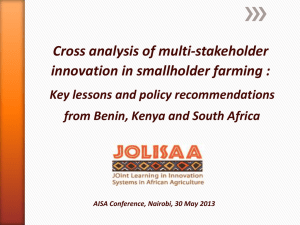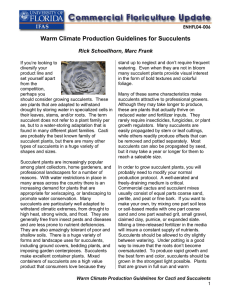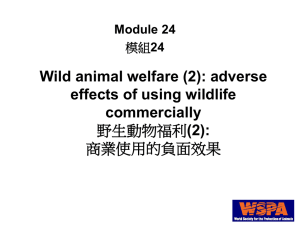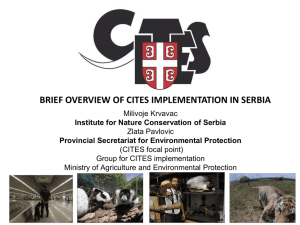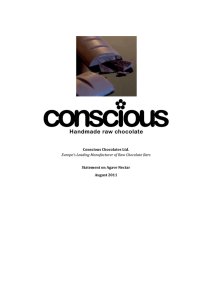CITES & Succulents
advertisement
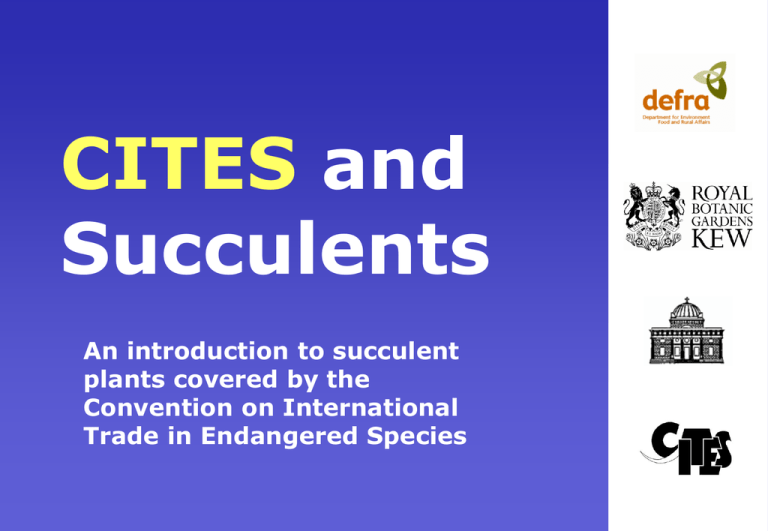
CITES and Succulents An introduction to succulent plants covered by the Convention on International Trade in Endangered Species What This Presentation Will Cover • Introduction to succulent plants • Succulent plants on CITES • Implementing CITES for succulent plants Introduction to Succulent Plants What Are Succulent Plants? Why Protect Succulent Plants? Global Trade What Groups Are Controlled? Cacti Succulent Plants on CITES Succulent Euphorbia Euphorbia Characteristics - Latex Euphorbia Characteristics Spines and Flowers • Spines – Needle like or – Complex – In pairs • Flowers – Inconspicuous – Showy bracts Global Distribution of Succulent Euphorbia No. Euphorbia taxa 250 200 150 100 50 1 0 Source: Carter & Eggli (1997) Euphorbia Trade Major Importer Major Exporter Source: UNEP-WCMC CITES trade data 1997-2001 Aloe Aloe Characteristics Aloe or Agave? Agave Aloe Agave Aloe Agave Aloe Global Distribution of Aloe No. Aloe taxa 150 100 50 1 0 Aloe Trade Major Importer Major Exporter Source: UNEP-WCMC CITES trade data 1997-2001 Pachypodium Pachypodium Characteristics Global Distribution of Pachypodium No. Pachypodium taxa 30 15 1 0 Pachypodium Trade Major Importer Major Exporter Source: UNEP-WCMC CITES trade data 1997-2001 Other Succulent Taxa Listed on CITES Agave Alluaudia Fouquieria Other Succulent Taxa Listed on CITES Medicinals Succulent Plants on CITES: Summary Implementing CITES for Succulent Plants Enforcement Enforcement - Checks • Check – Documents – Country of origin – Packaging – Shipments – Trade routes Wild or Artificially Propagated? Key Characteristics Wild • Irregular shape & size General • Wounds ?insect damage Appearance Artificially propagated • Uniform • Healthy plant parts • “Corky” stems Spines Roots Soil • Irregular & broken • Uniform & intact • Thicker • Thinner & weaker • Irregular • In shape of pot • Dead & broken • Roots cut back but healthy • Cut back when removed from the wild • Several main roots • Native soils and associated plants • One main taproot • Usually clean of soil • Horticultural soil present (e.g. peat, sand, perlite, rockwool) Wild or Artificially Propagated? AP - shipment Wild - shipment Wild - growth form AP - growth form Wild or Artificially Propagated? Wild - leaves AP - leaves Wild - spines AP - spines Wild - roots AP - roots Implementation: Summary Additional Slides Exemptions Nursery Registration The CITES Definition of ‘Artificially Propagated’ Detecting Detrimental Trade? The Burden on Exporting Countries • Article IV of the convention states that an export permit shall only be granted when, inter alia,’ • A Scientific Authority of the state of export has advised that such export will not be detrimental to the survival of that species’ Detrimental Trade - How and Why? • Insufficient resources to implement Article IV of CITES • Poor implementation of export bans on wild plants • Smuggling Tillandsia – Air Plants

